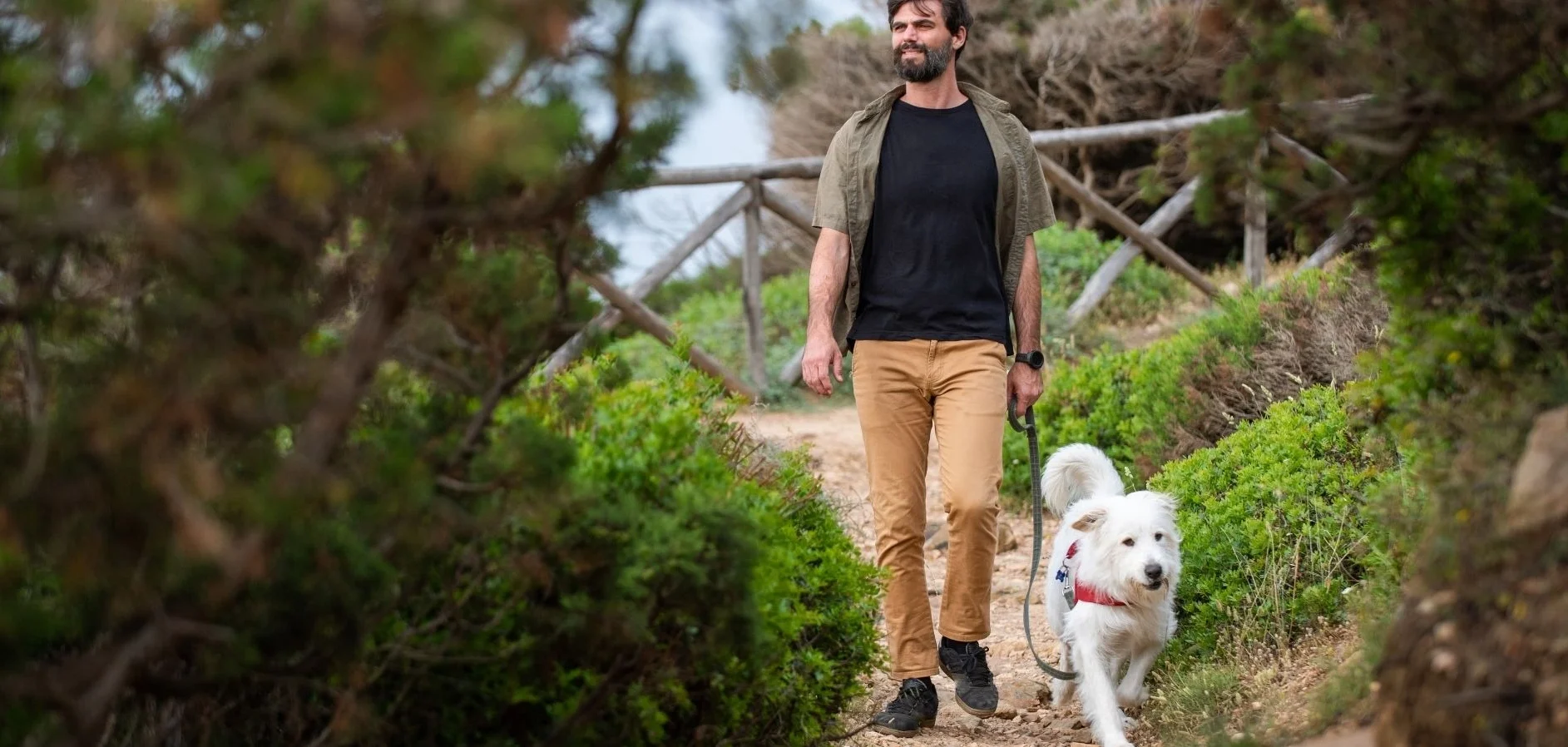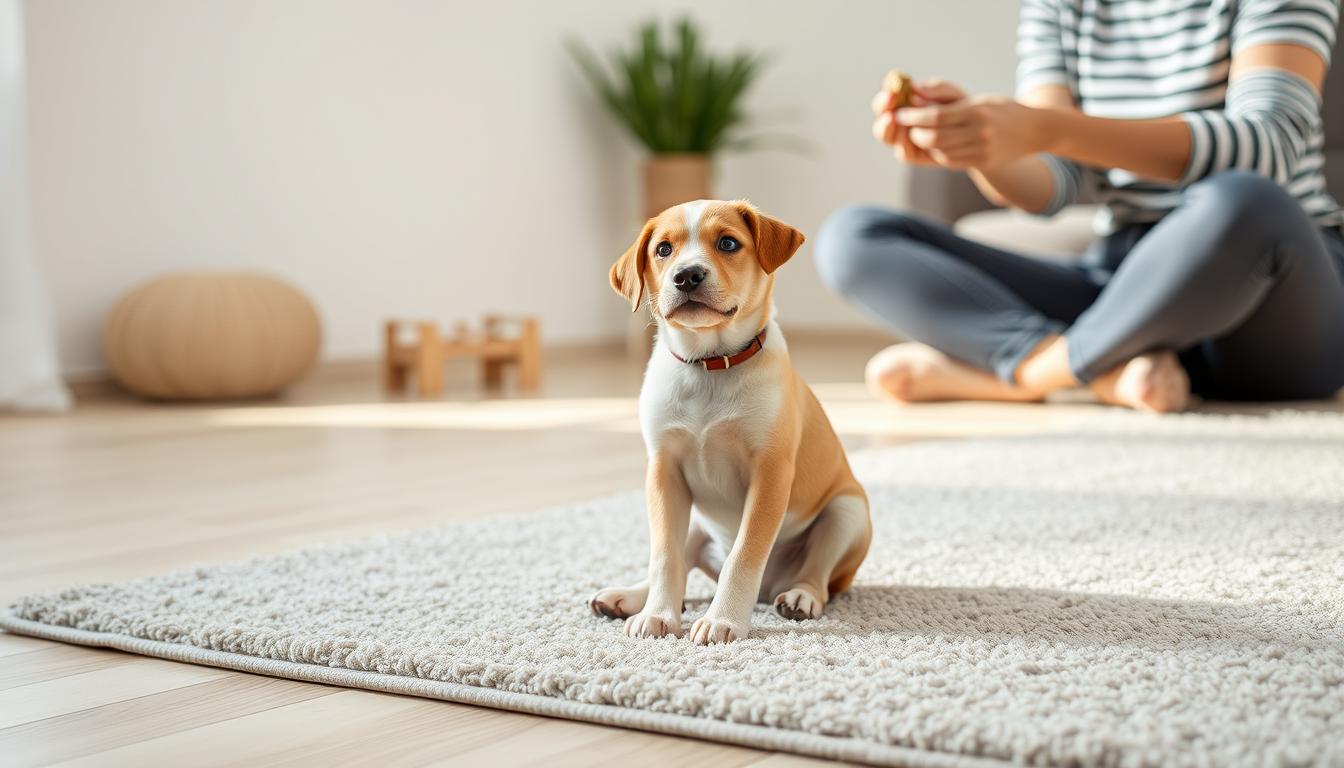How to Train a Puppy Sit: Easy & Patient Steps
Table of Contents
Teaching your puppy to sit is more than a cute trick. It’s the start of good behavior and helps them understand boundaries. Even puppies as young as 8 weeks can learn basic commands. This turns them into well-behaved pets.How to train a puppy sit is an essential first step when bringing home a new furry friend. Bringing home a new puppy is exciting and a bit overwhelming. It’s not just about teaching them tricks. It’s about building a strong bond of trust and communication. When I got my energetic Labrador, teaching him to sit was my first goal.
This guide will teach you how to teach your puppy to sit. You’ll learn about positive reinforcement and step-by-step training. You’ll gain the confidence to shape your puppy’s behavior.
Key Takeaways
- Puppy sit training can begin as early as 8 weeks old
- Positive reinforcement is the most effective training method
- Consistency is crucial in puppy training
- Short, frequent training sessions work best
- Patience and persistence are key to successful training
- Basic sit command is a gateway to advanced obedience
Understanding the Importance of Teaching Your Puppy to Sit
Teaching a puppy to sit is more than a simple trick. It’s a key skill for puppy obedience training. This command helps you communicate and control your pet, building a strong bond.
Building a Foundation for Advanced Training
The sit command is a crucial step for more complex training. By learning this, your puppy gains:
- Impulse control
- Attention to your commands
- Fundamental listening skills
“A well-trained sit is the gateway to more advanced obedience and communication with your dog.” – Professional Dog Trainer
Creating Trust and Communication
Teaching a puppy to sit does more than teach a physical action. It creates a language of communication between you and your pet. Each successful sit strengthens your bond and builds understanding.
Managing Excited Behavior
The sit command is key for controlling your puppy’s excitement. It helps in various situations, keeping your puppy calm and focused.
By spending time on this skill, you’re preparing a well-behaved, confident, and responsive pet. They will understand boundaries and enjoy learning.
When to Start Training Your Puppy
Timing is key when training your puppy to sit. Experts say start as early as 8 weeks. At this age, puppies are ready to learn basic commands.
Young puppies can learn fast because their brains are so open to new things. The first 16 weeks are especially important for learning the basics. During this time, your puppy’s brain is like a sponge, soaking up everything.
- Begin training sessions when puppy is alert and energetic
- Keep initial training sessions short (5-10 minutes)
- Practice multiple times daily
- Use positive reinforcement techniques
Your puppy can only focus for a short time. So, make training sessions short and fun. Consistency and patience are crucial for teaching your puppy to sit during these early weeks.
| Puppy Age | Training Readiness | Recommended Session Length |
|---|---|---|
| 8-10 weeks | High receptivity | 3-5 minutes |
| 10-16 weeks | Peak learning capacity | 5-10 minutes |
| 16+ weeks | Established learning patterns | 10-15 minutes |
Every puppy is different. Pay attention to how they react to training. The goal is to make learning fun and stress-free for them.
Essential Training Supplies and Setup
Getting ready for puppy sit training needs careful planning and the right tools. Success comes from having the essential supplies for effective and fun training sessions. How fast your puppy learns and responds to sit commands depends a lot on your preparation.
Choosing the Right Treats
Choosing the perfect treats is key for puppy sit training tips. Look for small, soft treats that your puppy can’t resist. Tiny pieces of cooked chicken, soft cheese, or specialized training treats work best. The goal is to find something that really motivates your puppy to learn.
- Use treats no larger than a pea
- Choose high-value rewards your puppy loves
- Opt for soft, easily consumed treats
- Rotate treat varieties to maintain interest
Creating an Ideal Training Environment
Your training space is very important for puppy sit training tips. Pick a quiet area with few distractions where your puppy can focus. A consistent, calm space helps your puppy learn better and avoids frustration.
Training Tools and Equipment
While not necessary, some tools can make your puppy sit training better. A clicker is a great tool for marking good behaviors precisely. Here are some tools to consider for your training:
- Clicker for precise behavior marking
- Treat pouch for easy reward access
- Short leash for controlled training sessions
- Comfortable mat or training area
Pro tip: Keep training sessions short and positive to maintain your puppy’s enthusiasm and prevent burnout.
The Science Behind Positive Reinforcement Training

Learning how to teach your puppy to sit starts with knowing how dogs learn. Positive reinforcement uses your puppy’s natural learning ways.
Positive reinforcement makes your puppy want to learn. When you reward good behavior, you teach your dog that good actions get great rewards. It’s more than just treats; it’s about connecting and understanding each other.
“Training should be fun for both the puppy and the owner. Positive reinforcement makes learning an exciting adventure.” – Professional Dog Trainer
The science behind this method is based on how dogs and humans learn. Dogs are more likely to do things that make them happy. Using rewards to teach your puppy to sit motivates them to learn.
- Builds trust between puppy and owner
- Creates a positive learning environment
- Encourages voluntary participation in training
- Reduces stress and anxiety during learning
Studies show that punishment can hurt your bond with your puppy. Negative training can make your puppy scared, anxious, and not want to learn. But positive reinforcement makes training fun and strengthens your bond.
| Training Approach | Puppy’s Emotional Response | Learning Effectiveness |
|---|---|---|
| Positive Reinforcement | Excited, Confident | High |
| Punishment-Based | Fearful, Anxious | Low |
By understanding these scientific principles, you can create a fun and effective training method for your puppy.
How to Train a Puppy Sit: Step-by-Step Guide
Teaching your puppy to sit is key for a strong bond and discipline. Good puppy sit training methods can change your life with your new pet. It takes patience, consistency, and the right way to do it.
Understanding two main methods is crucial for puppy training: the lure and capture methods. Each has its own benefits for teaching your puppy to sit well.
The Lure Method
The lure method is a favorite for teaching puppies to sit. Here’s how to do it:
- Hold a treat close to your puppy’s nose
- Slowly move the treat up and back over their head
- As their head tilts back, their bottom will naturally lower
- The moment they sit, say “sit” and reward them
“Patience and positive reinforcement are key to successful puppy training.” – Professional Dog Trainers Association
The Capture Method
Capture training is another great way to teach your puppy to sit:
- Watch your puppy closely during regular activities
- When they naturally sit, immediately mark the behavior
- Use a clicker or say “yes” to signal the correct action
- Reward them quickly while they’re still sitting
Marking and Rewarding Success
Marking and rewarding your puppy is key to teaching them to sit. Timing is everything – reward them right after they sit to make the behavior stick.
Common Training Mistakes to Avoid
Teaching your puppy to sit can be tough for new owners. Spotting and fixing common mistakes early is crucial. It helps you train your puppy better.
When you’re teaching your puppy to sit, some big mistakes can slow you down. Knowing these mistakes helps make training smoother.
- Inconsistent Command Signals: Using different signals can confuse your puppy
- Incorrect Reward Timing: Giving treats too late can mess up the connection
- Overtraining: Long sessions can make your puppy tired and lose interest
- Lack of Patience: Not being patient can stress your puppy out
Look out for problems like puppies jumping up instead of sitting. They might sit wrong or get up too soon. These signs mean you might need to change how you’re training.
Consistency and positive reinforcement are key to successful puppy sit training.
Every puppy is different. Short, regular training with treats right away works best. It helps your puppy learn to sit well.
Progressing from Basic to Advanced Sit Commands
Once your puppy knows the basic sit command, it’s time to take it to the next level. Advanced training tests their discipline and deepens your bond. By using new techniques, you’ll turn a simple command into a complex skill.
Starting with basic sit training is key to expanding your puppy’s skills. You aim to make the sit command reliable and useful in many situations.
Duration Training
Duration training helps your puppy sit for longer. Start with short times and increase it slowly. Here are some tips:
- Begin with 3-5 second sit durations
- Slowly extend sit time to 30 seconds
- Reward consistent, patient sitting
- Practice in calm, distraction-free environments
Distance Training
Distance training makes your puppy respond to sit commands from afar. This is key for off-leash control and advanced obedience.
- Start close to your puppy
- Gradually increase distance
- Use clear, consistent verbal cues
- Practice in safe, enclosed areas
Distraction Training
Distraction training teaches your puppy to sit in tough environments. This builds impressive focus and discipline.
| Distraction Level | Training Approach | Duration |
|---|---|---|
| Low | Mild background noise | 5-10 minutes |
| Medium | Moving objects nearby | 10-15 minutes |
| High | Public spaces with activity | 15-20 minutes |
Remember, training your puppy takes patience, consistency, and positive reinforcement. Each session boosts their confidence and strengthens your bond.
Incorporating Sit Commands into Daily Routines

Training your puppy to sit works best when you make it part of daily life. The secret to mastering the sit command is to practice it often in real-life situations.
Begin by turning everyday moments into training chances. Ask your puppy to sit before you cross streets, meet people, or go inside. This makes the sit command a habit and keeps your puppy safe and polite.
- Ask for a sit before meal times
- Request a sit when visitors arrive
- Practice sit commands during grooming sessions
- Use sit command before putting on leash
The aim of training your puppy to sit is to make it a natural action in many situations. Consistency is key. Every time you ask your puppy to sit, you’re building their muscle memory and improving your bond.
Try making sit commands a game. Give your puppy treats and praise when they sit in different places. This turns training into a fun way to bond.
Remember, patience and positive reinforcement are your best tools in puppy training.
By adding sit commands to your daily routine, you’ll help your puppy learn good behavior and strengthen your bond.
Troubleshooting Training Challenges
Training your puppy can sometimes face unexpected challenges. Every puppy learns in their own way. Knowing these challenges helps you train better and strengthens your bond.
Some common challenges include:
- Lack of focus during training sessions
- Physical discomfort preventing sitting
- Inconsistent command responses
- High-energy distractions
If your puppy doesn’t want to sit, check for physical issues first. Physical discomfort can be a big problem. Make sure your puppy isn’t in pain or stiff.
Creating the right training environment is key. Pick a quiet spot with few distractions. Short, regular sessions keep your puppy focused and eager to learn.
Here are some tips for overcoming sit command issues:
- Make treats more appealing
- Practice in different places
- Use positive reinforcement always
- Ensure your hand and voice cues are clear
Patience is crucial in training your puppy. Every puppy learns at their own speed. Stay calm and supportive for the best results.
Building Long-term Success with Consistency
Learning the sit command is more than just starting. Your dedication to regular practice will turn it into a natural skill for your dog.
Consistency is key in puppy training. Dogs love routines and clear rules. Set a regular training time that fits your day. Short, regular sessions keep them focused and happy.
- Practice sit commands in various environments
- Use the same verbal cue and hand signal every time
- Reward consistently with high-value treats
- Keep training sessions positive and fun
Keep track of your puppy’s progress in a journal. Note any improvements, challenges, and successes. Patience is key – some days will be better than others, but steady, gentle teaching will pay off.
As your puppy gets older, make the sit command harder. Add distractions, make it last longer, and practice in different places. This keeps the command reliable and flexible.
Remember, training is a journey of communication and bonding with your puppy.
Celebrate small wins and stay positive. Your excitement will motivate your puppy and strengthen your bond. This makes teaching the sit command a fun experience for both of you.
Conclusion
Teaching your puppy to sit is a key step in building a strong bond. Puppy sit training does more than teach a simple command. It lays the groundwork for communication and trust.
Patience and consistent practice are essential for successful training. Your journey will need dedication and positive reinforcement. Each session is a chance to grow closer and teach basic obedience.
Every dog learns at their own speed, so be patient. Celebrate the small wins. The skills you learn will help with more advanced training later.
Start using these methods today. You’ll see how fast your puppy can learn and grow. Your hard work will lead to a well-behaved, eager-to-please dog.
Begin your training journey now. Get treats, find a quiet spot, and start. Your puppy is ready to learn, and you’re ready to guide them.
There are no reviews yet. Be the first one to write one.


